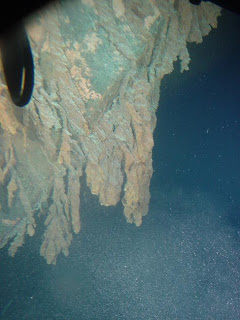Titanic, the world s best-known cruise ship was launched in May 1911, the ship sank in April 1912 after colliding with an iceberg en route from Southampton, England to New York City. Titanic was carrying more than 2,200 passengers and more than 1,500 reportedly died. Today, the Titanic rests, disintegrating at the bottom of the Atlantic Ocean, approximately 12,405 feet below the water’s surface.Take a look at a collection of amazing underwater images of the ship. A view of the bow and railing of the RMS Titanic.
Rusticles growing down from the stern section of Titanic.
Ethereal views of Titanic s bow (modeled) offer a comprehensiveness of detail never seen before.
The first complete views of the legendary wreck Titanic s battered stern is captured overhead here. Making sense of this tangle of metal presents endless challenges to experts. Says one, If you re going to interpret this stuff, you gotta love Picasso.
As the starboard profile shows, the Titanic buckled as it plowed nose-first into the seabed, leaving the forward hull buried deep in mud—obscuring, possibly forever, the mortal wounds inflicted by the iceberg.
National Geographic magazine s April 2012 issue provides the first-ever complete images of the Titanic wreck.
A view of the bow of the Titanic from a camera mounted on the outside of the Mir I submersible.
A view of the bow and railing of the RMS Titanic.
A view of the bow of the Titanic from a camera mounted on the outside of the Mir I submersible.
A view of the steering motor on the bridge of the Titanic.
A view of the bathtub in Capt. Smiths bathroom. Rusticles are observed growing over most of the pipes and fixtures in the room.
With her rudder cleaving the sand and two propeller blades peeking from the murk, Titanic s mangled stern rests on the abyssal plain, 1,970 feet south of the more photographed bow. This optical mosaic combines 300 high-resolution images taken on a 2010 expedition.
Detached rusticles below port side anchor indicating that the rusticles pass through a cycle of growth, maturation and then fall away. This particular crop probably was in a five to ten year cycle.
Rusticle hanging from the stern section of the RMS Titanic showing secondary growths during maturation.


































0 Comments